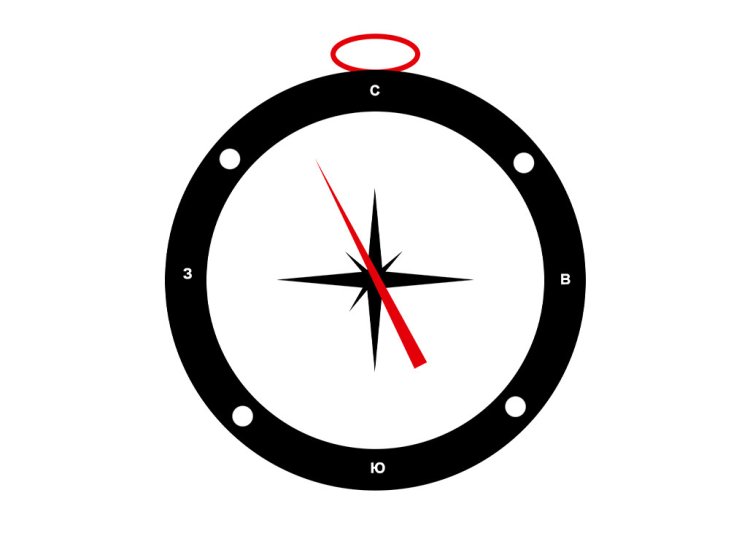One of the four great Chinese inventions is a compass, which was invented in the 3rd century BC, and today became a complex and high-precision device. Compasses are often associated with the development of navigation: indeed, the device for determining the cardinal points played a crucial role in traveling across the seas and oceans, although researchers tend to believe that the first compasses were used for orientation in deserts.
The first compasses looked like magnetite pouring spoons with a spherical “cup” and a thin light handle. The convex part was mounted on a carefully polished plate so that the handle remained in the air. At the same time, the spoon rotated freely around its axis – after the device was unwound, it stopped so that the handle always pointed to the south.
Later, in the 12–13th centuries, a floating compass needle appeared. The magnetized needle was fixed on the cork and lowered into a container with water. Unlike the first devices, the magnetized pointer did not rub against the surface, which means that the accuracy of the devices increased.
The device was improved by the Italian Flavio Gioia. He developed it practically to the form in which compasses are known today: he put a magnetic needle on a hairpin so that there was no need to lower it into the water, and attached a disk marked up into 16 sectors. In the 16th century, cards were already divided into 32 sectors, and the device with an arrow began to be placed in a gimbal to eliminate the influence of ship motions on the accuracy of the device.
Classic look
A white scale of degrees encased under glass, phosphorescent marks of the cardinal points and a magnetic arrow, an arrestor lock to fix the arrow. A familiar device could have been lying in a desk drawer in the Soviet Union times – this is the Andrianov compass, first designed in 1907. Today it can be called almost a classic example of a magnetic device.
Today, magnetic compasses are much more accurate than their predecessors and differ depending on the tasks for which they are used. A liquid compass, the predecessor of which was a magnetized needle in a container with water, is also a kind of magnetic compass. At the same time, it is partly superior to rigid-based structures. The usual magnetic needle is sealed in a flask with a non-freezing mixture. The viscous liquid stops the arrow faster and reduces its vibrations. Such compasses are often used by athletes.
Geological or mountain compasses are more complicated than tourist ones. In addition to the classical scale, a clinometer is installed in geological compasses – a device for measuring vertical angles. And the circular scale of degrees, unlike its classical counterparts, is marked not clockwise, but counterclockwise. This is due to another azimuth determination system. To measure it at a certain point, the north side of the compass is directed at the object. The compass is horizontally aligned, and the arrow is released from a fixed position. The azimuth to the object will be the reading on the scale indicated by the northern end of the arrow.
Gyrocompass
Gyrocompasses are more accurate than devices with a magnetized arrow. They are often mounted on ships to determine the course and azimuth and are used in rocket technology. Gyrocompasses do not point to the magnetic pole, which is a conditional point at which the Earth’s magnetic field is directed perpendicular to the surface, but to the true geographical one: the point through which the Earth’s axis of rotation passes. In addition, the accuracy of gyroscopic compasses is not affected by the magnetized parts of the container.
The gyroscope is able to respond to changes in the orientation angles of the body on which it is mounted. This property is used in the design of the gyrocompass. A rotor mounted in a gimbal can freely navigate in space. In modern devices, the gimbal is replaced by cameras that reduce the resistance when the gyroscope rotates. For example, these are sealed spheres filled with hydrogen, in which the contact of the chamber with the bottom of the container and the lid is regulated using a water jet.
The disadvantage of gyrocompasses is the complexity of the device, as well as a certain inertia. That is, with sharp maneuvers of the ship, the gyrocompass takes time to restore the readings.
Electronic and electromagnetic satellite compasses
Satellite devices are almost devoid of the disadvantages of magnetic compasses and gyrocompasses. Such devices determine the axes of the coordinate system associated with the ship relative to the axes of the geocentric coordinate system based on satellite signals.
A satellite compass consists of two or three antennas for receiving satellite system signals. The screen can display information about the course and position of the ship relative to the bottom, as well as speed and coordinates. At the same time, satellite compasses quickly provide information after switching on: unlike magnetic and gyroscopic devices, they do not need time to stop inertia.
Satellite compasses determine the course with an accuracy of up to tenths of a degree, regardless of the ship motions or maneuvers.
Based on open sources
Illustration: Alexandr Burmistrov, Scientific Russia






















